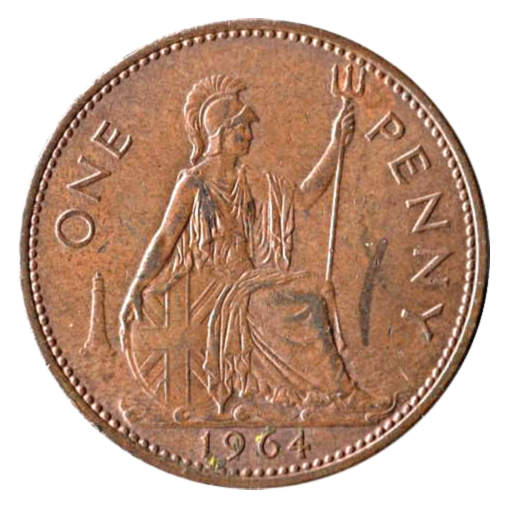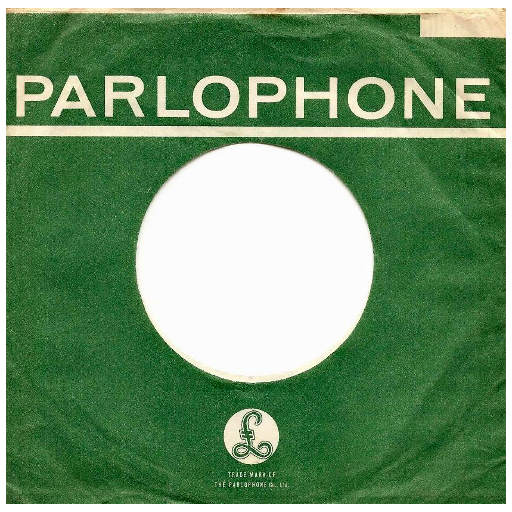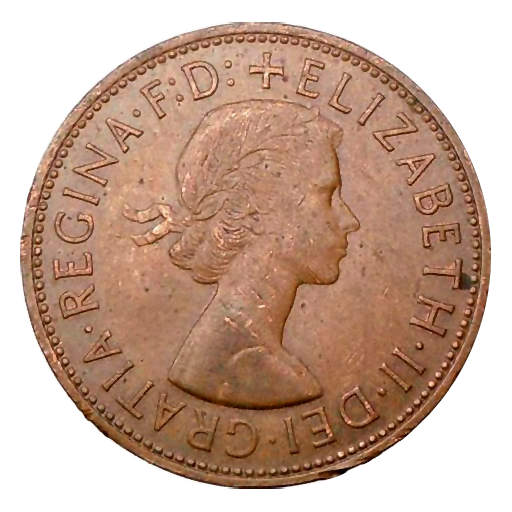The Magic Penny
In the days of LSD (librae, solidi, denarii or pounds, shillings and pence in the common tongue) the penny was a huge bronze coin, 1 7⁄32 inches across and weighing 1⁄3 ounce. The ‘tails’ side depicts a seated Britannia, holding a trident in one hand and a shield in the other, flanked by the words ONE PENNY, and a date stamp below. The ‘heads’ side shows a bust of the Queen with her name and some latin (DEI GRATIA REGINA F:D: concerning God and Faith, which survives to this day on the most modern sterling coins, even in our multicultural society) surrounding her like a halo of exclusivity.

In the early 60’s I was but a child and LSD was legal tender. So what can money mean to a child, these coins of the realm – most simply a deferred reward: a grown up gives you some coins and later you can go to a shop to exchange them for sweets. And it can teach you some ideas of value – so my mother would give me sixpence (6d) for the bus fare to school and I would walk there and back unless the weather was terrible, so I could spend it on sweets or American Civil War bubblegum cards, in the little shop by the railway station. Or if I wanted something for my train set I would have to defer the reward even longer until I had saved up enough for the piece of track or rolling stock. Or even on a couple of occasions, in a whirlwind of taste and perception, one of the early Beatles singles on Parlophone.
These 7” of black vinyl hosting a black label with white lettering in an olive-green paper sleeve, bearing the label PARLOPHONE in white letters with their trade mark resembling the pound sign £. All very conservative, completely hiding the revolution in music encoded in those miniscule bumps along the spiralling track. Entering the world of vinyl my sister and I were initiated into the secrets of the auto-changing record player, on which you could stack up multiple singles at a time.
And beyond money was the child’s awe, for me manifested in an older brother, one who had die-cast engines in his train set, who disappeared off on a scooter to a hidden world outside mine. Now I look back with incredulity at the freedom I enjoyed, that my parents entrusted in me, but at the same time I also felt constrained by childhood. I could barely watch Steptoe and Son for the empathy I felt for the son trapped by familial forces. I saw no comedy in that situation just a tragedy of classical proportions. Not that our Dad was an Albert Steptoe, far from it, but I felt embittered on Harold's behalf.
Once a year our father would take us along to his works fireworks party, on a large grassy sports ground, and I recall on several occasions the fire brigade having to be called out when the scrub beyond the field was set ablaze by stray sparks. His works colleagues would come over to our family group and say “Hello Jack”, which confused the hell out of me as his name was John, but his workmates shortened it to Jack. Now there is something I have never fathomed, how is Jack short for John – it has the same number of letters and syllables.
Trying to describe the appearance of a parent is surprisingly hard, the familiarity makes it hard to take an impartial perspective, and if you have aged along with them can you pinpoint them in time. It is like if you were to meet them in heaven, what age will they be, the age at which they died, and then are you the age you are when you died? Perhaps they will be younger than you in heaven. Maybe you meet them like in memories, at different times of their lives so their age is fluid. Many Christians have this idea that you will be in heaven at your perfect age. But what is my perfect age, looking back there are many; the perfect age for innocence – 7; the perfect age for cool – 23; the perfect age for adventure – 33; the perfect age for having it all – 48; the perfect age for a new life – 60.
Amalgamating various memories into a unified representation of Dad, as a person I can describe, is perhaps the best solution. Doesn’t everyone make their own image of a person which may or may not be an accurate portrayal but can never be a perfect representation because we do not have access to their innermost feelings and thoughts.

So Dad was this middle-aged man, dark hair, combed-over to cover his male-pattern baldness, medium height and build, brown eyes, and the requisite nose, mouth and ears. A quiet man in many regards, for the most part keeping his joy and anger to himself. His clothes were equally understated, a plain shirt topped with a dark jumper, grey trousers held up with a leather belt, dark socks and slippers on his feet. Not an especially active person, he would sit doing the crossword, playing the piano or doing the garden. But behind that placid exterior lay a bundle of fun and drama waiting for its moment. And the magic trick with the penny was one such moment. “Do the magic trick with the penny”, we would entreat, and on a very few occasions in those long years of our childhood, it would be brought out from behind his curtain of reserve.
There is an ideal atmosphere to draw out the theatre of the trick, darkness outside, a small group of eager children lit by a warm lightbulb, gathered around a small table. Dad disappears to collect together the props for the trick, an apple on a plate put aside out of reach, an empty plate put in the middle of the table, an envelope, matches, a knife, a pencil and the centrepiece a penny, one of those large brown d’s. Once set the drama begins. He picks up the pencil and hands it to one of us. “Now make a mark on the penny with the pencil so you know it is your penny. And the rest of you remember the mark so you know it too”. We all crowd together to see the penny marked, and to remember it as if our life depended on it.
He produces the envelope and holds it forward, flap open. “Now put the penny in the envelope”. The penny is dropped into the proffered envelope with the solemnity of a religious relic. “Now lick the envelope and fold the flap down”. He holds the envelope forward and a young tongue is rubbed along the line of glue. It is sealed by soft hands pressing the paper either side of the seal. Dad then holds the envelope aloft in front of the lightbulb. “You have marked the penny and put it into the envelope and sealed it. And you can see the penny in the envelope when I hold it up to the light”. Indeed we could, the shadow of the penny could be seen through the thin white paper. He then places the envelope on the plate in the middle of the table. “I’m going to set fire to the envelope and you must watch it to make sure it all burns up”. He takes a match out of the matchbox and after the mini-fireworks of the head has fizzed out he holds the match under one corner until the envelope is burning steadily. We watch like hawks, fascinated by the transformation of white paper into black ash by means of a flickering yellow flame. The flame is not a thing, you can see it but see through it, it has an edge but no skin, an ephemeral dancing curtain of light which is forever fascinating.
People have been mesmerised by fire and flames for millennia, and it similarly holds sway over children both its power to consume and transform. I bear witness to two boys taking their Airfix plastic model aeroplanes, filling the fuselages with newspaper, setting fire to them and throwing them out of a first floor bedroom window to see them crash to the patio and be engulfed in thick yellow flames with dense acrid black smoke billowing up as the plastic combusted. And I also bear witness to slightly older boys sitting in the back rows of the chemistry lab behind a wooden bench, solid enough to survive an earthquake. In those benches were wooden drawers, no longer used, and into which were placed Dinky toy cars, small metal models, stuffed with newspaper and set alight with a taper from the bunsen burner. The drawer would be closed and emergency action only taken if smoke started billowing out of the drawer sufficiently that the teacher might notice, in which case water from the beaker would be thrown in to extinguish the flames.
The burning of the envelope draws you in not only by the flickering flame but also by the way the boundary between the white of the paper and black of the ash propogates through the sheet, like an army advancing over a map, to leave a feathery ghost behind that will disintegrate at the merest hint.
Once we had watched the envelope burn through and seen that the penny had also been consigned to the flames, the plate was taken from the table and replaced with the plate bearing the apple. The knife was handed to one of us with the instruction: “Take the knife and cut the apple in half”, carrying with it a flourish of anticipation as if we were about to cut the lady in half.

The knife breaks the skin of the apple and penetrates the flesh down through the core until the two halves can be separated. And there in the heart of the apple is a penny.
“Take a look at the penny and see if it is yours. Does it show your mark on it?”
Of course it does, that is the trick. The penny is passed round to confirm that it is indeed the marked one, with cries of “How did you do that?” “Do it again”. A faint smile on his face and a nod of refusal indicates the end of the show. The props are cleared away and our regular Dad returns.
Years later I would work out for myself how it was done, and maybe I did perform it again, just the once to prove to myself it could be done. And it also proved, if it needed proving, that there is some of my Dad in me. Not all I hope, I bring my own experiences to my character, but undoubtedly I recognise some of his traits in me.
© Nick 2019